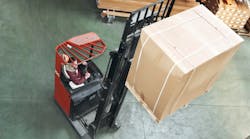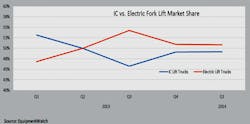In 2004, the Environmental Protection Agency (EPA) passed a mandate reducing off-highway engines emissions. It required the reduction of nitrogen oxide (NOx) emissions by 45% and particulate matter (PM) by 90%. This forced manufacturers of larger diesel-powered forklifts to modify engines to meet reduced NOx and PM standards.
Those manufacturers exhibited their ability to meet EPA Tier 4 requirements at this year’s ConExpo 2014. For example, Hyundai Construction exhibited the 7E line of forklifts that feature 162- 260 hp Cummins Diesel Engines that are certified EPA Tier 4 Compliant. Despite such innovations, many equipment owners have been running to the resale market to buy used forklifts—demonstrating willingness to pay more for older equipment as long as it is not Tier 4.
The EPA finalized its Tier 4 requirements in 2013, affecting engines between 50-75 hp. This year larger engines will be subjected to these emission standards. These changes affect the majority of internal combustion cushion tire and internal combustion pneumatic tire lift trucks with load capacities of 7,000 pounds and higher. The reason many equipment owners are hesitant to purchase the newer Tier 4 compliant models is uncertainty about maintenance requirements, general performance and resale opportunities. Long-term upkeep and equipment performance are also yet to be determined. Used equipment resale data analysis reflects those concerns about Tier 4.
To combat this prejudice, sellers are discounting Tier 4 certified models at prices at or below older non-Tier 4 models. For example, 2012 diesel forklifts are selling, on average 5-10% below 2011 models, which did not have as strict EPA standards. Similarly, 2006 & 2007 models are selling for the same or higher than 2008 or 2009 models.
Aside from price disparities, customers have highlighted their concerns with their purchasing patterns as well—over the past five quarters, internal combustion fork lifts under 5,000 lb. load capacities have seen their share of the market drop from 53% to 47%. Smaller forklift consumers are uncertain about Tier 4 and are moving toward electric forklifts in response to their doubts.
Patrick Dogan is manager of analytics for Equipment Watch, providers of construction equipment valuations and benchmarks. For more information, visit www.equipmentwatch.com.




